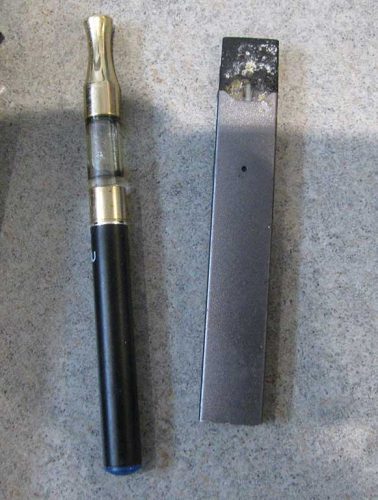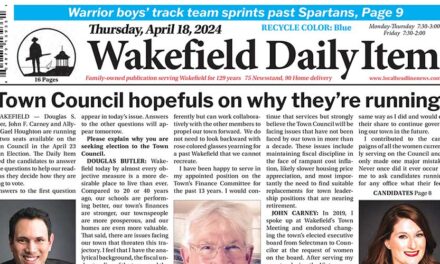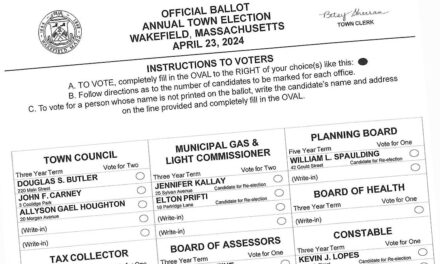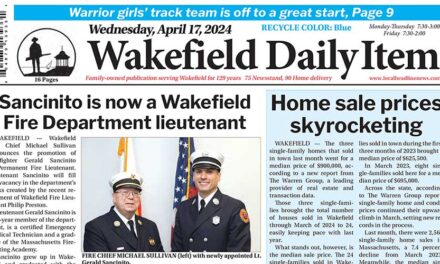Published in the May 24, 2018 edition.
By MARK SARDELLA
WAKEFIELD — Vapes, Juuls, e-juice and pods. Those terms might be unfamiliar to you, but your kids know what they are. Last night, several dozen local parents attended two separate one-hour seminars at the Galvin Middle School on one of the most concerning new trends among youth: vaping.
Vaping is a relatively new delivery system for one of the most addictive drugs known to man: nicotine. Some kids have also figured out how to hack the devices and use them to vape oil containing THC, the psychoactive chemical in marijuana.

TWO VAPING DEVICES, the e-gigarette (left) and the “Juul.” The Juul is very popular among adolescent vapers. (Mark Sardella Photo)
Last night’s sessions were led by Catherine Dhingra, the town’s Substance Abuse Prevention coordinator, along with Wakefield Police Officer Jason Skillings, the School Resource Officer at Wakefield Memorial High School, and Officer Kelley Tobyne, the Galvin Middle School Resource Officer.
Dhingra noted that decades of education and public policy measures have reduced cigarette smoking rates drastically. But data from the latest Youth Risk Behavior Survey showed that the number of kids regularly vaping more than doubled at Wakefield High School last year – from 15 percent in 2016 to 34 percent in 2017.
It’s also increasing at the Galvin Middle School, Dhingra noted. As she was leaving a recent meeting at the Galvin, she said, she saw several of the telltale discarded Juul pods in the parking lot.
Skillings showed several devices used for vaping, ranging from the older, large, awkward looking devices to the sleek new “Juul” favored by today’s youth. The Juul looks like a computer USB drive and is easily concealed.
“There’s really no fear of getting caught,” Skillings said. “It’s really prevalent.” The question every kid asks when he catches them with one in school, he said, is “When can I get my vape back?”
“They’re not even scared,” Tobyne added.
Dhingra showed an image of what the Juul “pods” look like. They are small cartridges that contain the nicotine liquid. Running through the pod is a sliver of metal that the battery-powered Juul heats up to vaporize the liquid “e-juice” into a vapor that the user then inhales into the lungs.
A single Juul pod contains the nicotine of 20 cigarettes. Officer Tobyne said that she has encountered kids who say that they use two pods a day – the nicotine equivalent of smoking two packs of cigarettes. The pods sell for $4 apiece, considerable cheaper than cigarettes.
Skillings said that it’s not unusual for him to find as many as eight discarded Juul pods on the floor of a bathroom at Wakefield High School.
Dhingra displayed examples of several types of nicotine oil used in the vaping devices. The manufacturers make them in flavors clearly marketed at kids, such as “Apple Caramel Drop,” “Smurf Cake,” “Mango” and “Gummi Bear.”
“They want life-long nicotine addicts,” Skillings said.
Tobyne said that kids in crisis are showing signs of more aggressive behavior in school. There are many reasons, she admitted, but noted that vaping and nicotine withdrawal are part of it.
“It shouldn’t be happening in high school or middle school,” she said.
Dhingra said that a lot of student athletes that would never smoke think it’s OK to vape. Some WHS athletes have been suspended from teams and have lost their captaincies because of being caught vaping. It was also noted that students could lose college scholarships as a result of consequences served for vaping in high school.
Skillings noted that a common denial kids use when caught vaping is to claim that they are merely vaping flavored liquid, without nicotine. That’s not true, he said. Virtually all of the liquids contain nicotine, he pointed out, because the manufacturers want the user coming back for more.
Skillings also noted that the kids are blissfully unaware of the other chemicals that are in the nicotine liquids, which are manufactured by fly-by-night companies that are unregulated.
Tobyne noted that the strawberry flavored oil bought in one store in town may be chemically totally different than the strawberry flavored oil bought at another store in town. But as far as the kids are concerned, they’re all the same.
“Who knows what’s in it?” she said.
Skillings said that young kids see these products prominently displayed at local convenience stores next to candy and gum and conclude that the products are safe. He said that parents who see such products displayed should not be afraid to shame the store owners by saying that they don’t want those products sold in Wakefield.
Skillings added that there are online videos that show kids how to hack into vaping devices, so they can be used with concentrated marijuana-based oils that are many times more potent than leafy marijuana.
Dhingra noted that surveys show that one-third of Wakefield High School students regularly use marijuana, and vaping is increasingly the delivery system used.
While vaping is marketed as safer than smoking cigarettes, Dhingra talked about some of the health consequences of vaping, including gum disease and a syndrome known as “popcorn lung,” where the oil that coats the lungs from vaping causes lung tissue to bubble up.
Dhingra listed a number of factors that contribute to substance use and abuse among youth, including family-related problems, school difficulties and peer groups and caregivers that use substances.
There are also some protective factors that make substance use and abuse less likely, she said. These include: strong parental involvement in the child’s life, trusted adults at school, clear limits and consistent enforcement of discipline, clear and consistent messages that substance use is not tolerated, academic success and high self-esteem.
The message last night was that by learning the facts about vaping, parents and other adults can help kids to avoid a lot of negative consequences
“Nicotine is one of the hardest drugs to quit,” Skillings said, “and it can prime a young brain for addiction to other things later on.”




